

Obverse
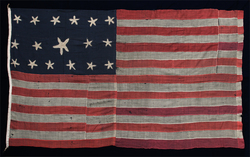
Reverse
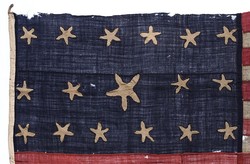
Canton - Studio Photo

Star Detail
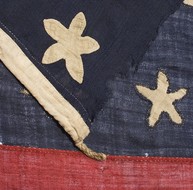
Star Ob. & Rv.
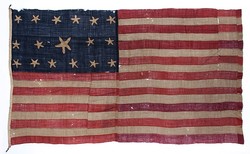
Obverse - 2
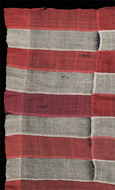
Patch - 1

Patch - 2

Patch - 3
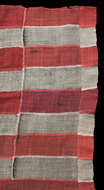
Patch - 4
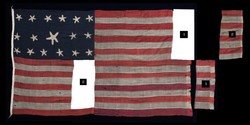
Patch Comparison
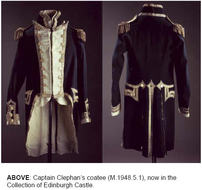
Clephan Uniform
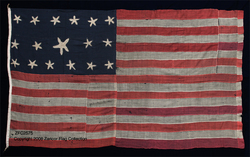
Copyrighr Reverse
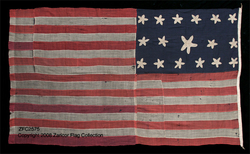
Copyright Obverse
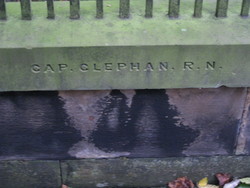
Clephan Grave -2
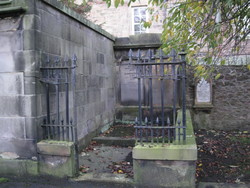
Clephan Grave -3
































































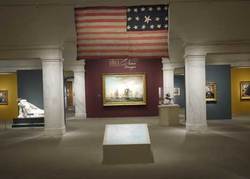
Flag at NPG exhibit
U.S. 17 Star, 17 Stripe Privateer Ensign.
Sub-collection: Napoleonic Wars & War of 181217 Star, 17 Stripe U.S. Ensign, Privateer Blockade, War of 1812 captured by Captain James Clephan, HMS Charybdis
AMERICAN PRIVATEER BLOCKADE IN THE WAR OF 1812
By
Harold D. Langley*
After years of the failure of diplomatic and legislative efforts to resolve outstanding problems with Great Britain, President James Madison decided it was time for a new approach. On June 1, 1812 he asked the United States Congress to declare war on Great Britain. The United States had tried unsuccessfully to continue trading as a neutral with countries in Europe in the midst of a long war. Great Britain and its Continental allies were fighting against France under the control of Napoleon Bonaparte and his supporters. Both sides sought to restrict the commerce of its enemy. To meet the needs of blockading squadrons off French controlled territory, the British impressed seamen from American merchant vessels. Americans were also concerned about reports that British agents were stirring up the Indian tribes in what was then the northwest frontier of the nation. Members of Congress had long been aware of the deteriorating relations with Great Britain but took no actions to prepare the nation for war. Also a large number of members of Congress as well as the citizenry were opposed to war. Nevertheless Congress declared war on June 1 8, by a vote of 79 to 49 in the House of Representatives and 1 9 to 1 3 in the Senate. But it was not until June 26 that Congress passed a law granting the president the power to issue Letters of Marque and Reprisal, or the authorization to license citizens to engage in privateering under certain conditions.
The interval between the president's war message and the passage of the law authorizing the issuing of Letters of Marque and Reprisal gave some men in various states the opportunity to prepare ships for privateering activities. While New England as a whole was against the war, there were some in the maritime community who had lost money as the result of earlier
Congressional laws restricting trade with areas affected by the war. For them privateering, or private armed warfare on the seas, offered the possibility of making money by arming and manning their merchant vessels and attacking British merchant ships. To engage in such activity required applying to the president for a Letter of Marque and Reprisal. This was done through the Collector of Customs at designated ports. The applicant had to give the name, tonnage, and force or armament of the privateer, well as the name and residence of each owner of the vessel, and the intended number of crew members. The commander of the vessel would post a bond of $5000 and names two "sureties", or responsible persons with no interest in the vessel, who would guarantee that the terms and conditions of the Letter of Marque were carried out and to cover any damages or claims. If a privateer vessel had a crew of 150 men then the bond required was for $10,000. When the requirements were satisfied; the Collector of Customs issued an official license or Letter of Marque and Reprisal, to the commander of the vessel. Information in the application papers was sent o the president through the Secretary of State.
It is interesting to note that in Massachusetts, a David Higgins applied to a Collector of Customs for a Letter of Marque two days before Congress declared war. His privateer was the brig Gossamer, with 19 guns and 101 men. A Letter of Marque for this ship, issued on July 16, named Charles Goodrich as the commander and Elijah Mix as the lieutenant. Whether the
ship actually sailed and whether Mix was with it has not been ascertained. Another item of interest is that on August 12, 1 81 2 an Elijah Mix was granted a protection or license to import a cargo of dry goods to a port in the United States. Perhaps that was in relation to the preparation of a privateer. Whatever the exact circumstances were, it seems possible that an Elijah Mix, who was a privateer in the American Revolution, may have had a son with the same name who was similarly active in the War of 1812.
In Connecticut there was also an interest in outfitting privateers. On September 12, 1812 Joseph Belden of Hartford sent a letter to the Collector of Customs at Middletown, Connecticut, requesting a Letter of Marque. He said that he was the sole owner of a schooner named Blockade, which had been built at the shipyard in Glastonbury. It was 81 feet four inches long and 20 feet nine inches wide and had a depth of 8 feet 6 1 / 2 inches. The bow was sharp and the stern was square. The ship had one deck, no galleries and two masts. He believed it was about 128 tons. It was Belden's intention to place ten guns on the ship and to man it with 75 men. The commander was Elisha Mix. No lieutenant was named in the application. The Collector later explained to Secretary of State James Monroe that when the Letter of Marque was issued the name of the lieutenant was inserted but not added to the retained copy. An abstract of the Letters of Marque issued by the Collector and sent to Monroe shows that on September 15, 1812 one was issued to Joseph Belden for the schooner Blockade commanded by Elisha Mix. The ship's tonnage was 1 28.48 tons and the armament to 15 guns, 14 of which were described as "carriage guns." This meant that they were mounted on wheeled wooden carriages to permit them to be moved in and out of the gun ports on the deck. The 15th gun may have been mounted in the bow of the ship and may have fired a smaller shot. No mention was made of the weight of shot of any of the guns. This discrepancy in the size of the armament noted in the application and that which appeared in the license or Letter of Marque was not explained and is inconsistent with several later reports of the ship. Perhaps the weight of the addition guns interfered with the sailing of the vessel and their number was reduced. According to a Hartford newspaper account, the Blockade sailed from Connecticut in September 1812, probably a day or two after receiving the necessary papers. It also seems to have gone to New York, perhaps for supplies, ammunition or a refitting. This may be the basis of some later reports that the ship was from New York. When it left that port it headed for the West Indies where it hoped to find British merchant ships.
While sailing in the West Indies near the island of Saba on October 31, 1812 the Blockade was sighted by HMS Charybdis, a 385 ton British navy brig carrying eighteen 32~pound guns and a crew of 121 under Commander James Clephan, R.N. At 1 1:30 a.m. the British ship fired on the privateer. The commander of the Blockade knew that his ship was no match for the warship and began to flee with the Charybdis in hot pursuit. The two ships
exchanged cannon fire and 28 officers and men of the Charybdis were killed or wounded and 8 on the Blockade. In an attempt to lighten the ship and sail faster the Blockade later threw overboard nine guns. According to an account in the London Gazette, the battle lasted one hour and twenty minutes. The British ship overtook the Blockade and captured it. The dead were apparently buried at sea and the wounded on both sides were probably cared for by the surgeon of the Charybdis. According to the master's log of the Charybdis, the American prisoners were transferred to the British ship along with 720 pounds of bread. A British officer and six men were sent to the Blockade to take the ship to the island of St. Thomas. Other information indicates that the prize was taken to the British island of Antigua for condemnation by a prize court. Copies of some pages of the log of the Charybdis indicate that the ship continued to seek other American privateers for at least a few days after the battle. Presumably the wounded were transferred to a hospital, perhaps in Bermuda.
Newspaper and later book references to the Blockade offer a wide range of information on the number of guns that it carried as well as the size of its crew. In the United States, the Baltimore based Niles Weekly Register, thought that the privateer had 8 guns. The Gentleman's Magazine in London said it had 10 guns and 66 men. Lloyd's List, published by the insurance company, Lloyd's of London on January 1, 1813, declared that the privateer carried 7 guns and 72 men. Some Canadian newspapers stated that the American ship had 14 guns and a crew of 75 men. The discrepancies are reflected also in various 1 9th Century books.
Adding to the confusion is the fact that a second privateer named the Blockade received a Letter of Marque from the Collector of the district of Bristol, Rhode Island on November 18, 1812. This one weighed about 109 tons had a crew of 80 and carried 9 guns that fired a 12-pound shot. The commander was Manley Sweet and Thomas H. Russell was the first lieutenant. The present researcher is not aware of its war record.
On the matter of throwing guns overboard to escape a pursuer, Edgar Stanton Maclay in his 1899 book A History of American Privateering commented as follows. "There are many instances of American privateers running away from each other and throwing overboard the guns, under the impression that they were in the presence of an enemy, because there was no efficient code of signaling between the regular war craft and the privateers, or among the private armed craft themselves." (p. 25) Be that as it may, there was no doubt that the first privateer Blockade found itself in the presence of a powerful enemy and did everything it could do to escape.
It seems likely that the surviving members of the crew of the Connecticut privateer Blockade, who were prisoners of war, were exchanged within a year of their capture. The surviving records of such exchanged prisoners in the National Archives in Washington do not show the name of Elisha Mix. When he returned to the United States he established his residence in New York City and presumably engaged in maritime activities. He was still living in New York at the time of the Census of 1830.
As for Captain James Clephan (1768-1 851) his life is a tale of a man of humble origins who rose to a position of much responsibility and finished his life in comfortable circumstances. Born in the town of Kirkcaldy in Scotland, and at the age of twenty-one he went to work in a factory in town that made linen. As the operator of a loom he presumably transformed flax fiber into thread and later the thread into cloth. In January 1788 he bought his own loom and entered into business for himself. By February of the following year he knew that he could not support himself by this means and he joined the merchant service of Great Britain.
The beginning of the French Revolution in July 1789 and the efforts of European powers to prevent the spread of its ideas and threats to monarchies led them to engage in a war against the French. In the beginning Great Britain remained neutral. But when the armies of Revolutionary France threatened the Netherlands that country invoked its treaty with Britain. France then declared war on Great Britain on February 1, 1793. Parliament authorized the strengthening of the Army by 17,000 men and the Navy by 9,000 seamen. These seamen were customarily drawn from the fishing and merchant fleets. Naval recruiters organized as press gangs descended on ports and villages in search of manpower. Immediate manpower needs were met but the sweep also brought into the navy a number of discontented persons who created serious discipline problems. Such was not the case when twenty-six year old James Clephan was forced into naval service. His maritime background led to his being rated as an Able Bodied Seaman and assigned to the 26 gun HMS Sybyl. He responded positively to his new environment and was an effective member of the crew. A year later he was promoted to master's mate while serving again under his previous captain in a new ship, the 36 gun HMS Doris. This assignment led to service in the North and the Irish Seas.
The role of the Royal Navy was to patrol the seas in search of French vessels. For the Channel Fleet it meant cruises from Spithead in Great Britain and into the Bay of Biscay. An observation squadron was also posted off Ushant, an island off the southern entrance to the Western English Channel. This force intercepted a French fleet that was awaiting a convoy bringing grain from the United States. The first British naval victory of the war took place on June 1, 1794 when seven ships were sunk and four prizes were taken. But the French had lured the British away from the grain convoy which reached port safely and brought much needed food. Clephan's ship was not in this battle. The Doris was a part of a squadron stationed off Ireland to prevent foreign aid from reaching Irish rebels who were fighting for independence. Things became more complicated when Spain signed a treaty with France in August 1796 and declared war on Great Britain on October 5. A combined French and Spanish fleet was defeated in the battle off Cape St. Vincent on February 14, 1797. Clephan missed this battle as well but he continued to grow in his naval environment.
Meanwhile French armies invaded the Netherlands in the winter of 1794-95 and the prince of the Dutch Orange-Nassau dynasty fled to England. The years 1794-95 saw the end of the Reign of Terror in France, and later the emergence of moderates in the government. A constitution was adopted in 1795 which vested executive power in a five man Directory. Under the Directory a French army under Napoleon defeated the Austrians and conquered Italy. After occupying Rome, Napoleon announced the formation of a Roman Republic. Later he collected an army at Boulogne and threatened an invasion of England. Instead he decided to attack Britain's Indian empire by way of Egypt. He invaded Egypt and defeated the force sent against him. But elements of the British Navy under Admiral Horatio Nelson defeated the French navy in the battle of the Nile in August 1 798. Napoleon returned to France where he became the First Consul or the leader of a three man government. In December 1799 the French public adopted new constitution which gave the appearance of a republic but in established the one man rule of Napoleon. In 1 800 the war against Austria was resumed and in February 1801 it led to a treaty whereby Austria ceded some territory to France.
While all this was unfolding, the Royal Navy tried to block the flow of ocean commerce to European ports under the control of the French. It was also concerned about the buildup of naval forces under French control.
In 1801 the Doris and two other British ships under the command of Captain Charles Brisbane were watching a group of Spanish and French ships anchored at Camaret Bay, near the French port of Brest on the North Atlantic. The French corvette Le Chevrette entered the bay on the night of July 21, 1801 and observed the British ships. The French captain decided that it would be safer to anchor his ship under the protection of the shore batteries. In addition troops were stationed on the ship and a redoubt or an enclosed fortification was built at Pointe du Grande Gouin. Also a guard boat with two 32-pound cannon as armament was stationed in the bay. The British decided that they would try to board and capture Le Chevrette at night in a
cutting out operation and take it to their awaiting force off shore. Midshipman Clephan was a part of this cutting out group. Another part of the venture involved sending six boats to search for the guard boat. When that force failed to return by midnight, Lieutenant Maxwell of the cutting out force decided that he could wait no longer. His force had to cover a distance of six miles to reach Le Chevrette. Later, as the British boats drew near their goal, the French saw them and opened fire with muskets and grape shot from cannons. Clephan was wounded and knocked overboard, but he was recovered and was a part of the force that boarded the ship. The French defenders who were not killed, wounded or who jumped overboard gathered below. From that area they kept their assailants at bay with musket fire while they attempted to blow up the quarter deck. In the end they were subdued and the corvette was cut loose from her moorings and taken to the British force anchored off the point. Subsequently Clephan was praised for his conduct in a report to Admiral Sir William Cornwallis and was promoted to acting lieutenant for the duration of the cruise of the Doris. On July 31, 1801 Clephan was commissioned as a lieutenant and assigned him to the 90 gun ship of the line, HMS Namur.
Years of warfare ended for a time when Great Britain, France and Spain signed the Treaty of Amiens in March 1 802. The following month Clephan was paid off and placed on leave in a half pay status. He returned to Scotland where in Kirkcaldy on November 21, 1802 he married Elizabeth Fowlis. Their first child, a daughter, was born in 1803.
By that time there were new tensions in the relations with France. Great Britain refused Napoleon's demands that the Mediterranean island of Malta, which the British captured in 1800, be returned. There were also charges that British ships had fired on French vessels in a bay near the port of Brest. Anticipating a new outbreak of war, the British Admiralty again sent out press gangs on March 10, 1803. All ships in the Royal Navy were made ready for active service. Among them was the HMS Spartiate, a former French warship that had been captured by Nelson in the Battle of the Nile. James Clephan was offered the position of a second lieutenant in the ship and he accepted. The ship was ready for service by April 1 0, and with two other ships she sailed to Cawsand Bay near Plymouth. War against France began again on May 1 803. Napoleon sent an army to Boulogne and threatened Britain with an invasion. A British squadron took a position off Brest to watch for any sign of this threat. Another squadron was to watch for the French and to British interests in the Mediterranean. In September she joined the blockading squadron off Ferrol and Coruna in northern Spain. She departed from this area the day before a hurricane struck in December 1 804 and for a time was presumed lost. But she survived severe weather storms and arrived safely in Beerhaven Bay in Ireland on January 1 6. From there she sailed to Plymouth in March for another refitting.
Meanwhile, in 1804 Napoleon was proclaimed emperor of the French. His plans for an invasion of England were well along. Part of his plan was to lure the blockading squadron from Brest so the invasion force could sail. In March 1805 eleven ships were to sail from Brest and pick up eight others at Cadiz and head for the Caribbean island of Martinique. There they were to join twenty-one ships that escaped from Brest and five from Rochefort. This combined force was believed to be sufficient to overcome the British ships in the English Channel. The invasion force would then be escorted to landing near Chatham in south eastern England. Ships under the command of Admiral Lord Nelson including the Spartiate took the bait that was offered and chased French warships to the West Indies and back. Unfortunately for Napoleon's plans, concerns about the weather prevented the French warship that remained in port from supporting the invasion effort. Napoleon then gave up his invasion scheme and focused his attention on his continental rivals. In 1805 Austria, Russia and Sweden joined in the war against France
and Spain.
The war at sea took a decisive turn when the combined fleets of France and Spain sailed from Cadiz on October 19, 1805. They headed for the Straits of Gibraltar with the goal of reaching Italy, where Napoleon intended to use them. The departure was witnessed by Nelson's observation frigates, while his main force was over the horizon. Later, when the French commander observed Nelson's force bearing down on him, he ordered his ships to return to Cadiz. Nelson divided his force into two columns and headed for close combat with the French-Spanish ships. Off Cape Trafalgar at 1 2:25 pm on October 21, Nelson's ship, HMS Victory, opened fire on the Bucentaure, the French flagship. Other British ships engaged enemy ships opposite to them. The last ship in Nelson's column was the Spartiate, which cut off the 84 gun Spanish ship Neptune and opened fire on her. On the opposite side of the Neptune, HMS Minotaur also engaged the enemy ship. At 5:10 p.m. the Neptune surrendered. During the battle the masts, yards and rigging of the Spartiate were greatly damaged and its fore-top yard was shot away. Three of her crew were killed and 20 were wounded. Enemy casualties were 73 wounded and killed. Throughout the fight Clephan displayed courage and after the battle he was rewarded by being promoted to first lieutenant. His crew presented him with the ship's Union Jack flag that had flown in the battle. Trafalgar ended Napoleon's attempt to challenge Great Britain at sea.
It was also the Royal Navy's last major battle under sail.
Clephan continued to serve in the Spartiate until December 1 809 when he was again placed on a half-pay status. This ended when he was ordered to the 74 gun HMS Dragon, the flagship of Sir Francis Laforey. Assigned to the West Indies with a base in the Leeward Islands, probably on the island of Antigua, the Dragon sought French ships that were trading with that nation's colonies in the area. During this assignment Clephan was promoted to Captain and given the command of the 1 8 gun sloop Charybdis. His responsibilities increased when the United States declared war on Great Britain in 1812. Now his duties included stopping American trade with the region and the protection of British commerce from attacks by American privateers. While performing this assignment he captured the American merchant ship William Rathbone on October 8, 181 2 and the privateer schooner Blockade on 31st of that same month.
Later in 1814-15 his ship was a part of the unsuccessful British effort to capture New Orleans. When the British army force was defeated, Clephan's ship carried the news to Great Britain. There he learned that a treaty ending the war had been signed by American and British delegates at Ghent in the Netherlands on Christmas eve in 1814. Thus the battle of New Orleans was fought after the war had ended.
With the end of the War of 1812, and the subsequent defeat of Napoleon at Waterloo in June 1815, peace returned to the Western world. The Royal Navy revered to a peace time basis. Clephan continued to serve until his retirement in October 1 840. He resided in Edinburgh until his death in 1851.
* All of the information on Captain James Clephan, his ships and the capture of the Blockade is based on the compilation prepared for and copyrighted by Fog Kist of Santa Cruz, CA. When necessary this information was clarified and supplemented by additional information provided by the author of this piece. All research on privateer Blockade, Captain Elisha Mix, Letters of Marque, privateering and aspects of the War of 1812 was done by the author in pertinent Federal records at the National Archives and the Mystic Seaport Library, Mystic, Connecticut, and in published sources in the Library of Congress and a private collection.
Private Exhibition
Washington Flag Congress, 2011
24th International Congress of Vexillology and
45th annual meeting of the North American Vexillological Association.
Washington, DC & Alexandria, VA
July 31-August 6, 2011
Smithsonian Institution
National Portrait Gallery
Washington, DC
1812: A Nation Emerges
14 June 2012 to January 2013
Provenance:
• American Privateer Blockade, 1812.
• Captured by H,M.S. Charybdis, Captain James Clephan, R.N., commanding, 31 October 1812.
• Retained as a trophy by Capt. James Clephan, R.N., retired, until passing, 1851.
• By descent in the Clephan family until 2008.
• Acquired by purchase via private treaty by the Zaricor Flag Collection, 2008.
Sources:
Urban, Sylvanus, The Gentleman's Magazine: and Historical Chronicle From January to June 1813, Vol. LXXXIII, Part the First, London, Nichols, Son and Bentley, 1813.
Niles, H., The weekly Register, From September 1812 to March 1813 - Vol. III, Baltimore, The Franklin Press, 1813.
James, William, Full and Correct Account of the Chief Naval Occurrences of the Late War between Great Britain and The United States of America, London, T. Egerton, 1817.
By Authority of the Admiralty, The Navy List, corrected to The 20th December, 1847, London, John Murray, 1848.
Colburn's United service Magazine and Naval and Military Journal - 1851- Part 1, London, H. Hurst, 1851.
Thomson, John L., History of the War of the United States with Great Britain in 1812, and of the War With Mexico, Philadelphia, J.B. Lippincott Company, 1887.
Robinson, Commander Charles, The British Fleet, London, George Bell & Sons, 1894.
Elliot, Andrew David, THE FAMILY HISTORY - a genealogy, published for private subscription, David Andrew Elliot, 2009.
James Clephan, Wikipedia, 2 October 2011, from:
http://en.wikipedia.org/wiki/James_Clephan
HMS Charybdis, Wikipedia, 2 October 2011, from: http://en.wikipedia.org/wiki/HMS_Charybdis_(1809)
Image Credits:
Zaricor Flag Collection
Hoist & Fly | |
|---|---|
| Width of Hoist | 69 |
| Length of Fly | 115 |
Union/Canton | |
|---|---|
| Width of Union/Canton | 32 |
| Length of Union/Canton | 52.5 |
Stars | |
|---|---|
| Comments on Star Measurements | Size of Stars varies, arranged in 6-5-6 horizontal rows |
Stripes | |
|---|---|
| Width of 1st Stripe | 4.75 |
| Width of 3rd Stripe | 4.75 |
| Width of 8th Stripe | 3.5 |
| Width of Last Stripe | 4.25 |
| Size of Hoist | 1.25 |
Frame | |
|---|---|
| Is it framed? | no |
| Comments on Frame | Flag is backed for horizontal display. Backing applied in Jan. 2012 |
Stars | |
|---|---|
| Number of Stars | 17 |
| How are the stars embeded? | Sewn |
| Are there stars on obverse? | yes |
| Are there stars on reverse? | yes |
| Comments on Stars | Stars are "flower" shaped rather than the sharp-pointed stars traditionally seen. |
| Star Pattern | 6-5-6 horizontal rows |
Stripes | |
|---|---|
| Number of Stripes | 17 |
| Color of Top Stripe | Red |
| Color of Bottom Stripe | Red |
| Has a Blood Stripe? | no |
| Comments on Stripes | Stripes pieced and patched together. White is consistent, red is from at least two different dye lots. |
Crest/Emblem | |
|---|---|
| Description of Crest/Emblem | Canton has a large center star |
Nationality | |
|---|---|
| Nation Represented | United States |
Fabric | |
|---|---|
| Fabric | Wool |
| Comments on Fabric | Very loose open weave Bunting |
Stitching | |
|---|---|
| Stitching | Hand |
Thread | |
|---|---|
| Thread Material | Cotton |
| Comments on Thread Material | Some seams and fly use a 2ply linen |
Attachment | |
|---|---|
| Comments on Method of Attachmen | Through header |
| Method of Attachment | Loops |
Applica | |
|---|---|
| Applique Sides | Single Faced = Mirror Image Reverse |
Documentation | |
|---|---|
| Documents | |
| Drawings | |
| Research Documents | |
Condition | |
|---|---|
| Condition | Good |
| Damage | Used, soiled, repaired, worn |
| Displayable | yes |
Date | |
|---|---|
| Date | 1803-1812 |
Exhibits | |
|---|---|
| Exhibition Copy | 56 1812: A Nation Emerges, an exhibition at The National Portrait Gallery, Smithsonian Institution, Washington, D.C. 1812 Seventeen-star, Seventeen-Stripe Flag Hand-sewn wool bunting with cotton stars, 175.3 x 292.1 cm (69 x 115 in.), 1812 Veninga-Zaricor Family / www.zaricorflagcollection.com This handmade seventeen-star, seventeen-stripe U.S. flag flew on the American schooner Blockade after President James Madison issued a letter of marquee on September 15, 1812, making it a privateer legally permitted to take prizes during the War of 1812. The 128-ton schooner, commanded by Captain Elisha Mix, carried about ten guns and a crew of about seventy and sailed out of Connecticut. She was captured off the island of Saba in the Caribbean on October 31, 1812 by the Charybdis, a 385-ton, eighteen-gun British navy brig with a crew of 121 commanded by Captain James Clephan (1768-1851). In the one-hour and twenty-minute battle, twenty eight officers and men of the Charybdis were killed or wounded to eight on the Blockade. The Blockade was eventually sold as a prize od war, and Clephan retained the flag as a trophy. No other seventeen-star, seventeen-stripe flag exists in the United States. The rounded, rather than the traditional sharp pointed stars are the flag's most striking feature. The pattern of three rows of irregular stars can be traced back to the American Revolution. The stripes and the canton off the flag are made of handwoven single ply worsted wool. The stars are made of cotton and contain the numerous irregularities of handspun fabric. The reinforcing stitching on the hoist is tarred, and the entire flag bears the hallmarks of being made by either a ship's chandler or sailmaker. The flag remains in remarkable condition because of the care it received from the Clephan family, where it remained for almost two hundred years before coming to its current owner in 2007. |
| Exhibition Images | |
Publications | |
|---|---|
| Publication Copy | Hart, Sidney, and Rachael L. Penman, 1812: A Nation Emerges, Smithsonian Institution Scholarly Press, Washington, DC, 2012 pp. 146-147. 56 1812 Seventeen-star, Seventeen-Stripe Flag Hand-sewn wool bunting with cotton stars, 175.3 x 292.1 cm (69 x 115 in.), 1812 Veninga-Zaricor Family / www.zaricorflagcollection.com This handmade seventeen-star, seventeen-stripe U.S. flag flew on the American schooner Blockade after President James Madison issued a letter of marquee on September 15, 1812, making it a privateer legally permitted to take prizes during the War of 1812. The 128-ton schooner, commanded by Captain Elisha Mix, carried about ten guns and a crew of about seventy and sailed out of Connecticut. She was captured off the island of Saba in the Caribbean on October 31, 1812 by the Charybdis, a 385-ton, eighteen-gun British navy brig with a crew of 121 commanded by Captain James Clephan (1768-1851). In the one-hour and twenty-minute battle, twenty eight officers and men of the Charybdis were killed or wounded to eight on the Blockade. The Blockade was eventually sold as a prize od war, and Clephan retained the flag as a trophy. No other seventeen-star, seventeen-stripe flag exists in the United States. The rounded, rather than the traditional sharp pointed stars are the flag's most striking feature. The pattern of three rows of irregular stars can be traced back to the American Revolution. The stripes and the canton off the flag are made of handwoven single ply worsted wool. The stars are made of cotton and contain the numerous irregularities of handspun fabric. The reinforcing stitching on the hoist is tarred, and the entire flag bears the hallmarks of being made by either a ship's chandler or sailmaker. The flag remains in remarkable condition because of the care it received from the Clephan family, where it remained for almost two hundred years before coming to its current owner in 2007. SH (Sid Hart) |
| Publication Images | |




















































































































































